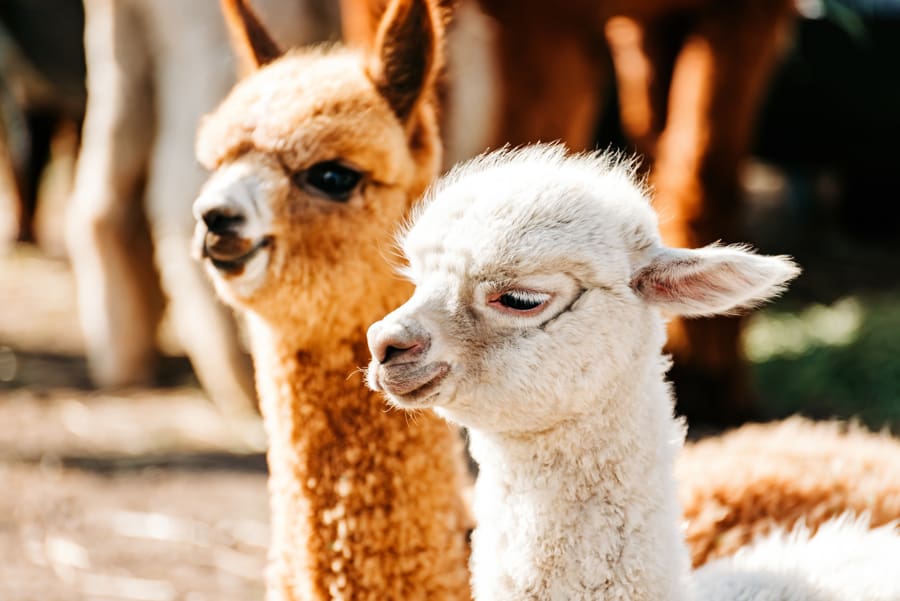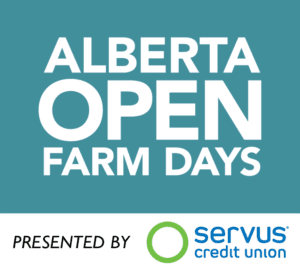
This year we are shining a spotlight on one of agricultures fluffiest animals and an important part of Albertas fibre industry – the alpaca.

Alpacas from Sunnyhill Alpacas in Leduc County Photo: Karissa Johnson
Did you know? Alpacas are a relatively new species to Alberta farms, and while there were alpacas in Alberta in the 1980’s the largest importation of alpacas into Canada happened in 1992. At this time 362 of the animals arrived at the Edmonton International Airport in Nisku, Alberta. The animals had a long journey, starting in Chile, and then quarantine in New Zealand for over a year and a half before they arrived in Canada. The 362 alpacas arrived on a A 747-cargo plane from Auckland, New Zealand to the international airport at Nisku , Alberta where 170 of them were dropped off at the Nisku federal quarantine facility. Since then the Alpaca’s have grown to 28,500 alpacas in Canada with 40% of those animals right here in Alberta (stats from 2020), and have become an important part of Alberta’s thriving fibre industry which includes products such as goats wool (cashmere), sheep wool and hemp.
Alpacas originate from the High Andes of Bolivia, Peru and Chile and are adaptable to the Alberta climate and make a great addition to a farm as they make great companions with
The United Nations has designated 2024 as the International Year of the Camelid, of which the alpaca, along with Bactrian camels, dromedaries, guanacos, llamas, and vicuñas, belong. The designation is to celebrate and highlight the importance of these animals around the world particularly the importance of their fibre!
Facts about Alpaca Fibre
- Alpaca fibre comes in variety of colours, including, white, black, brown, grey, fawn and any combination of these colours. Alpaca fibre comes in the widest assortment of colours of any fibre bearing animal!
- Alpaca’s produce fibre that is as fine as cashmere, soft, silky and much warmer and stronger than sheep’s wool.
- Alpacas are sheared once a year in the spring, producing on average between five to 10 pounds of fibre a year. The main yield is from their “blanket”, or the part of the alpaca’s coat that comes from the barrel of its body.
- Alpaca fibre on average is 20 to 36 microns (by comparison human hair exceeds 100 microns).
- Alpaca fibre is strong and durable – a hollow fibre that is remarkably warm.
- Did you know that alpaca fibre is non-allergenic and repels water?
- Unlike lamb’s wool, alpaca fibres are free of lanolin which provides wool that’s hypoallergenic and doesn’t require harsh chemicals and high temperatures during processing.
- There are two types of alpaca – the huacaya and the suri. Each type of alpaca produce a different fleece types!

Alpacas from Sunnyhill Alpacas in Leduc County Photo: Karissa Johnson
What’s the difference between Alpacas and Llamas?
Alpacas and llamas are both members of the camelid family which makes them camelid cousin! Alpacas and llamas are also cousins with other members of the camelid family such as the Bactrian camel, the Dromedary, as well as the vicuña and guanaco.
Although they may look similar, alpacas are quite different from the cousins the llama, starting with size and temperament! Llamas are significantly larger than alpacas with llama’s growing up to 400 pounds and alpacas weighing in at about 150 pounds. Alpacas are also much more timid than their llama cousins who prefer to be solitary and can be very brave (they can often be used as guard animals for other herds). Alpacas, prefer to be in their herd and need protection.
You will also notice a difference in the fleece from an alpaca which is much more luxurious, soft as well as longer and finer that the short and course fibre of a llama.
Here are 6 ways you can tell the difference between an alpaca and a llama!

Helpful Links:
Read more about the fascinating history of alpacas in Canada here
Read more about the UN Year of the Camelid here
Learn more at Alpaca Canada or at the Alpaca Livestock Producers And Cooperators Association

